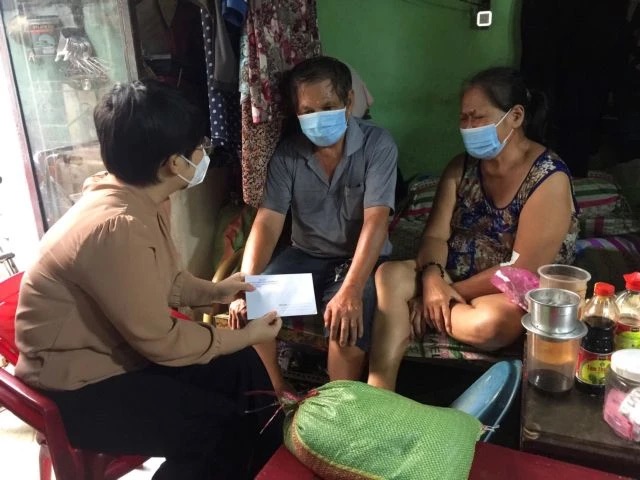The HCM City People’s Committee has submitted a proposal to provide an additional allocation of nearly VNĐ2.9 trillion (US$114 million) for the city’s sustainable poverty reduction programme for the 2021-25 period.

|
| An official of HCM City’s District 5 visits and presents a gift to a disadvantaged household. — VNA/VNS Photo |
HCM CITY—The HCM City People’s Committee has submitted a proposal to allocate nearly VNĐ2.9 trillion (US$114 million) more for the city’s sustainable poverty reduction programme for the 2021-25 period.
At the 17th session of the municipal People’s Council meeting held on July 15, the People’s Committee proposed that the People’s Council revise the multidimensional poverty measurement criteria, including the average income criteria of VNĐ46 million ($1,805) per person per year.
Indicators measuring basic social services include nutrition, health insurance, adult education level, school attendance status of children, job, social insurance, dependents in the family, housing quality, housing area per capita, domestic water source, hygienic latrines, telecommunications services, and means of accessing information.
The People’s Committee also proposed poverty thresholds for poor and near-poor households, and households with average living standards in the 2021-25 period.
Accordingly, people with an average income of VNĐ46 million or less per year and lacking three or more indicators measuring basic social services are certified as near-poor households.
People with an average income from VNĐ46 million to VNĐ69 million ($2,705) per year are those certified as households with an average standard of living.
The city’s sustainable poverty reduction programme for the 2021-25 period has a total capital of VNĐ15.1 trillion ($595 million).
Under the city’s poverty standards for the 2021-25 period, a poor household has an average income of below VNĐ36 million ($1,530) per person per year, and a near-poor household from VNĐ36 million to VNĐ46 million ($1,950).
Measures to help the poor include loans, vocational training, job introduction and scholarships, as well as support for education, housing, healthcare, and legal aid for the poor and near-poor.
The solutions and policies supporting socio-economic development are implemented to gradually reduce financial assistance and increase support for production and businesses, helping poor and near-poor households lift themselves out of poverty.
Localities and departments regularly review and update the list of poor households to promptly provide support.
By the end of last year, the city had more than 8,290 poor households and 14,574 near-poor households, accounting for 0.33 per cent and 0.57 per cent of the city’s total households, respectively. — VNS
- Reduce Hair Loss with PURA D’OR Gold Label Shampoo
- Castor Oil Has Made a “Huge” Difference With Hair and Brow Growth
- Excessive hair loss in men: Signs of illness that cannot be subjective
- Dịch Vụ SEO Website ở Los Angeles, CA: đưa trang web doanh nghiệp bạn lên top Google
- Nails Salon Sierra Madre
 VnExpress News The News Gateway of Vietnam
VnExpress News The News Gateway of Vietnam





